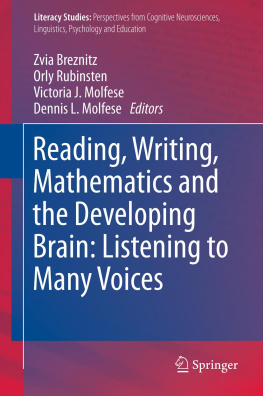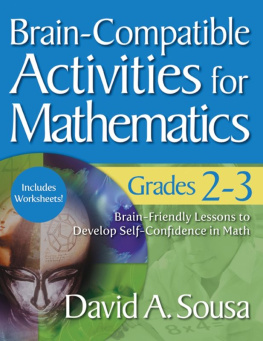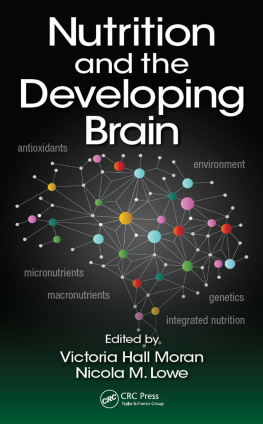Zvia Breznitz , Orly Rubinsten , Victoria J. Molfese and Dennis L. Molfese (eds.) Literacy Studies Perspectives from Cognitive Neurosciences, Linguistics, Psychology and Education Reading, Writing, Mathematics and the Developing Brain: Listening to Many Voices 2012 10.1007/978-94-007-4086-0_1 Springer Science+Business Media B.V. 2012
Abstract
Reading and writing skills are important for effective communication in a literate society. The human brain was created about 60,000 years ago and the alphabetic code only about 5,000 years ago. No brain system was created specifically for reading or writing skills and both skills needed to use and rely on a variety of brain systems. Despite this, about 75% of the literate population can read properly while about 25% have reading difficulties and impairments. The first section of this book contains nine chapters focusing on brain and behavior studies of literacy and language skills; seven chapters on reading and two chapters on writing and motor skills. These chapters include reviews of theories and research on reading and language development in typical, learning disabled and dual language samples, as well as reviews of neuroanatomical and neurophysiological methods, traditional and innovative interventions applied to selected samples of child and adult participants, and data analysis approaches. Collectively, these chapters provide a comprehensive introduction to many of the topics of interest to researchers, practitioners and students seeking to understand how the behaviors well known to characterize children and adults with reading, writing or spelling disabilities are reflected in measures of brain processing and behaviors and influenced by interventions. Further, these chapters provide information on how the results of different techniques of brain imaging and behavior remediation are interpreted to further of our knowledge of the effects of developmental and intervention on behavior change.
Reading and writing skills are important for effective communication in a literate society. The human brain was created about 60,000 years ago and the alphabetic code only about 5,000 years ago. No brain system was created specifically for reading or writing skills and both skills needed to use and rely on a variety of brain systems. Despite this, about 75% of the literate population can read properly while about 25% have reading difficulties and impairments. The first section of this book contains nine chapters focusing on brain and behavior studies of literacy and language skills; seven chapters on reading and two chapters on writing and motor skills. These chapters include reviews of theories and research on reading and language development in typical, learning disabled and dual language samples, as well as reviews of neuroanatomical and neurophysiological methods, traditional and innovative interventions applied to selected samples of child and adult participants, and data analysis approaches. Collectively, these chapters provide a comprehensive introduction to many of the topics of interest to researchers, practitioners and students seeking to understand how the behaviors well known to characterize children and adults with reading, writing or spelling disabilities are reflected in measures of brain processing and behaviors and influenced by interventions. Further, these chapters provide information on how the results of different techniques of brain imaging and behavior remediation are interpreted to further of our knowledge of the effects of developmental and intervention on behavior change.
Chapter by Molfese, Molfese, Garrod and Molfese, entitled Evidence of Dynamic Changes in Brain Processing from Imaging Techniques: Implications for Interventions for Developmental Disabilities, reviews the critical cognitive skills known to underlie the development of reading, and in particular, studies showing how the development of speech perception and phonological processing skills are related to the development of language and reading skills. The chapter then focuses on studies of brain processing differences in typically developing infants and children as well as in those at risk or evidencing language and reading disabilities using event-related potential (ERP) techniques. A dynamic neurocognitive model is described that connects findings from behavioral studies of language and reading skills to findings from brain imaging studies of brain structure and function changes arising from maturation and experience.
Chapter by Rezaie, Simos, Fletcher, Denton and Papanicolaou, entitled Magnetic Source Imaging: A Suitable Tool of Exploring the Neurophysiology of Typical and Impaired Reading Ability, provides background in Magnetoencephalography (MEG) techniques and the application of magnetic source-imaging measures to studies of brain structure and function. The use of this technique in clinical studies of reading disabilities is described as are findings from studies of children and adults involved in interventions. The use of magnetic source-imaging techniques in understanding changes in brain structure and function due to development and experience can inform both basic and applied research.
Chapter by Molfese, entitled Imaging Studies of Reading Disabilities in Children, provides a comprehensive review the ERP technique and its uses in studies of children with and without reading disabilities. The heart of the chapter targets studies using different brain imaging techniques (ERP, MEG and functional magnetic resonance imaging [fMRI]) with children with reading disabilities who are responding to reading intervention compared to those who are not responding. Molfese reports findings from an ERP study showing evidence of normalization of brain processing in children with reading disabilities who are responding to a reading intervention and activation profiles that more closely resemble those of typically developing children.
Chapter by Shaul entitled A Model of Brain Activity of Young as Compared to Adult Dyslexic Readers, and Outcomes After Intervention, targets the understanding of similarities and differences in the brain processing related to reading and several reading-related tasks in samples of children and adults with dyslexia. Cognitive profiles of adults with and without dyslexia, and 4th grade children with and without dyslexia are described. The differences and similarities in the cognitive profiles as related to the participants responses to the Reading Acceleration Program provide evidence of intervention effectiveness for both children and adults with dyslexia and suggests opportunities for further studies seeking evidence of the effects of intervention on longer-term changes in brain processing.
Chapter by Chuntonov and Breznitz, entitled Optimizing Reading Enhancement: Evidence from Brain Research, targets cross-linguistic studies in a review of how measures of brain and behavior responses are involved in the development of reading and reading-related skills. The review of brain imaging techniques and neuroscience leads to a review of intervention studies linking brain measures with reading behaviors. Findings from intervention studies using the Reading Acceleration Program with children and adults are described and support the view that existing and new circuits can be activated through training in both children and adults.
Chapter by Horowitz-Kraus, entitled The Error Detection Mechanism Among Dyslexic and Skilled Readers: Characterization and Plasticity, describes the use of the ERP technique to study brain activation related to error detection (ERN) and correct-related negativities (CRN). The chapter provides an overview of studies investigating errors on cognitive tasks, and studies to localize ERN and CRN in brain regions. Behavioral and brain studies of children and adults with dyslexia are described, as are the results of studies on the effects of intervention or training reflected in ERN and CRN.











